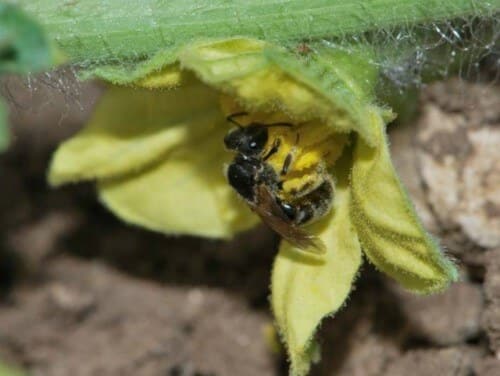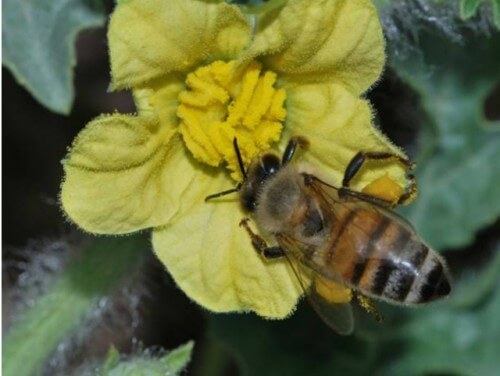Honey bees have been considered one of the main pollinators of agricultural crops until now. In many cases the breeders place beehives in the fields and orchards mainly to receive pollination services from the bees.

Despite the enormous technological progress in recent decades, our world depends today more than ever on agriculture. Not only the bread, vegetables and breakfast cereals reach us thanks to the farmers, but also all the meat, milk and egg products are completely dependent on the yield of the fields that grow food for cattle and poultry. Also other industries such as textiles, pharmaceuticals and nowadays increasingly also the energy industry, depend on the farmers and their products.
The agricultural crops themselves depend on a long list of environmental factors: water, soil, temperature, as well as on pollinators - insects (and to a small extent other animals) that transfer the pollen grains from a male flower to a female flower, and enable the development of the fruit and the creation of the seeds.

Honey bees have been considered one of the main pollinators of agricultural crops until now. In many cases the breeders place beehives in the fields and orchards mainly to receive pollination services from the bees. The beekeepers (or beekeepers, according to the terms of the language academy) benefit from the honey yield. However, the first international study of its kind reveals that the role of honey bees in this system is much less than what was believed until now. The main burden of pollination of agricultural crops falls on the wild insects: beetles, flies, butterflies and especially - wild bees.
A world of bees
The honey bee (Apis Mellifera) is one species of bee, probably the most common due to being domesticated bees used in honey production and pollination. But the group of bees (superfamily Apoidea) includes thousands of species, in which bees live at different levels of social organization (similar to the social system of honey bees), and also solitary bees, in which each female builds her own nest. There are bees that nest in holes in the ground, or in plants, and there are parasitic bees that do not bother to build nests at all, but lay their eggs in the nests of other bees. In Israel alone there are more than 1,000 species of wild bees. Researchers believe that the number of wild insects in the world as a whole has been decreasing in recent years, partly due to the reduction of open wild areas and the increased use of pesticides against harmful insects for agriculture, which also kill non-harmful insects.
Worldwide research

In the new study, an international team of researchers, led by Prof. Lucas Garibaldi from the University of Rio Negro in Argentina, asked to try to examine the importance of wild insects in global agriculture, and to check whether the reduction in their number affects the extent of the crop. They collected samples in 600 fields of 41 different crops, in 20 countries on all six continents that have agricultural areas. From turnip fields in New Zealand, through coffee plantations in India, almond plantations in the USA, blueberry plots in Canada, almond plantations in Germany to grapefruit orchards in Argentina. They also tried to check the importance of honeybees to agricultural systems. In 14% of the agricultural areas tested there were beehives and honey bees infested the crops. A team of researchers from the Faculty of Agricultural, Food, and Environmental Sciences of the Hebrew University also participated in the study. The team was headed by Dr. Yael Mandelik, along with Dr. Ohad Afik and research student Gideon Pizanti. They sampled wild bees in Israel in several watermelon patches, and discovered that the main pollination in this crop is mainly done by three species of wild bees.
There is no substitute for nature
In the global study, the researchers found a direct relationship between the frequency of visits by wild insects in a field or orchard, and the yield of the fruit and seeds of the crops. In fact, the wild insects increased the yield of the field about twice as much as the honey bees alone. With this, in the article published today in the journal Science, the researchers report that a combination of wild insects and honey bees resulted in another increase in yield, and therefore they conclude that the domesticated bees can help the wild insects, but cannot serve alone as a substitute for the pollination of the natural insect population. "The findings show that pollinators have a much more important role than they thought until now, and they disprove the popular opinion that it is possible to fulfill all the needs of agricultural pollination by placing honey beehives," says Dr. Mandlik. "It is likely that we should continue to use honey bee hives, but a way must be found to better manage the open areas surrounding the open areas, so that the populations of the wild pollinators can exist in them, as well as effectively manage the agricultural areas themselves - especially when it comes to spraying pest control If we find ways to make the conditions in the agricultural areas and their surroundings more friendly for the beneficial insects, it can work to the benefit of the farmers and expand the scope of crops."
An optimistic finding
In recent years, beekeepers around the world are not licking honey. In addition to disturbances such as the reduction of agricultural and wild areas, air pollution, and other environmental factors, the breeders have to deal with a long list of bee diseases. In the United States, almost half of the honey bee population was destroyed by a mysterious disease, which was called "Colony Collapse Disorder" (CCD), and later it turned out that it was probably caused by the virus attacking the bees. The phenomenon spread to a smaller extent to Europe as well, and there were also reports of similar damage to beehives in Israel. On top of that, the beekeepers have been dealing with the varroa epidemic for several years - a mite that attacks bees and eventually destroys their population without appropriate pesticides. These epidemics cast such a heavy shadow on the bee industry, that at certain times it was estimated that it was on the verge of complete collapse. "The research findings are encouraging in this context," says Dr. Mandlik. "The bees do provide us with a safety net for pollination, but we now know that agricultural pollination is not completely dependent on them, and agriculture will not go down the drain in the event of a collapse of the bee population."
Abstract of the article on the Science Express website

3 תגובות
For Alon, the conclusion was clear, wild insects are important for pollination, regarding the solution, it was not part of the article, but one can think of any number of solutions such as biological control.
Science needs to develop small robotic bees that will pollinate the agricultural crops.
Excellent article! But his conclusion remains ambiguous, even if the wild bees contribute a lot to the agricultural crops I still don't understand how you propose to make it so that the other harmful insects do not infiltrate the crops..